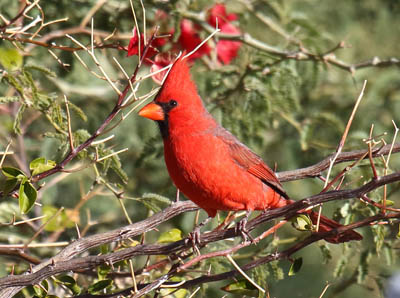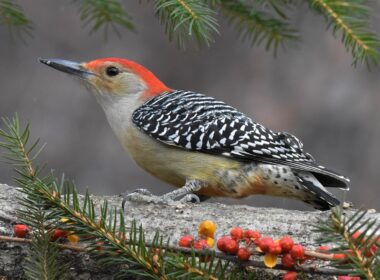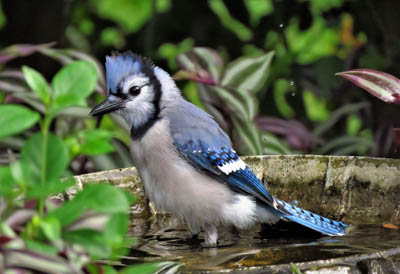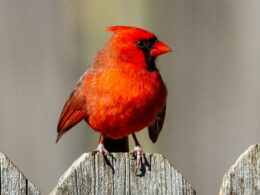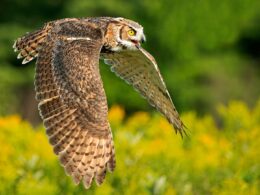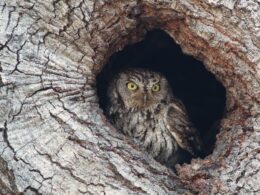Last Updated on January 24, 2024 by Greg Gillson
If you live on the edge of open country habitat, including farmlands, prairies, and fields you may have Barn Owls visit your yard. In fact, even if you live in town there may be Barn Owls near you that you can attract to your yard.
Barn Owls are found widely across the United States where winters aren’t too harsh and snow not too deep. These owls are rare to absent in the New England states, most of the northern parts of the Midwest and Great Plains and northern Rocky Mountain states. Otherwise they are found in the Pacific Northwest from Washington State southeastward to Colorado, eastward to Iowa and Kentucky and Connecticut. From these locations they are found southward from California to Florida.
Barn Owls are the top owls you want to get rid of rodent pests, especially mice. They are excellent rodent hunters. In fact, a single Barn Owl will eat 3-4 prey items per night. That’s about 1200 rodents per year! A pair of Barn Owls will feed on about 4000 rodents a year when factoring in feeding the chicks! (source)
According to research done for the book Birds of Oregon: A general reference (Amazon link), Barn Owls eat 55-91% field mice (voles). Deer mice make up the balance at 6-32% of the diet. Barn Owls hunt while flying low over the ground, unlike Great Horned Owls that generally hunt from a perch. Thus, Barn Owls avoid areas with perches (such as woods), as Great Horned Owls will kill and eat Barn Owls.
 |
|
Barn Owl roosting in aspen tree
Photo by Greg Gillson
|
What makes your yard attractive to Barn Owls?
Ideally, to attract a Barn Owl you would live on the edge of agricultural lands and have a large open barn, silo, grain elevator, or craggy cliff on your property. I realize that these requirements will probably eliminate most yards.
However, if your yard is mostly open and on the edge of a large field, golf course, cemetery, creek, school ball field, park or green space, you may be able to attract Barn Owls. Even if your yard is on the edge of a rural town you may be able to encourage Barn Owls to nest in your yard.
The main thing you need to attract Barn Owls is a place to set up a nest box. This can be placed in a large tree, on a pole, or in a barn.
Barn Owls like to hunt in the dark. Consider putting your lights on timers that turn off later in the night.
Barn Owls may take baths in large birdbaths!
Barn Owls are frequently killed by motor vehicles. They hunt low to the ground over fields and may be struck as they fly low across country roads. If your yard is next to such a busy road, perhaps it would be best not to attract owls.
A second common cause of Barn Owl mortality is rat poison. If such poison is used to control rodents on or near your property, then it would not be appropriate to try to attract owls.
What about owls and pets?
There is a lot of misinformation about owls and their potential to attack pets. In the United States you have much more to worry about over coyotes at night than you do owls.
Larger owls, like Great Horned Owls can certainly hunt and kill small pets. They can’t carry more than 4 or 5 pounds, though. So they’re not going to fly off with your pet unless very tiny. But their talons are incredibly sharp and would certainly severely injure anything they attack. And rarely they’ve been known to hunt feral cats or domestic ones left out at night. But that’s very dangerous. Rabbits are much safer prey for owls to hunt than cats and dogs.
Barn Owls are much smaller than Great Horned Owls. Their prey is mostly mice that they swallow whole. They aren’t going to hunt dogs and cats.
However, the Barn Owls will defend their nestlings right near the nest. So if the cat decides to stalk the owls, or the dog gets too curious, well, that’s going to end badly for someone. The hissing of an angry mother owl would likely make most cats and small dogs run for home!
 |
|
Barn Owls in a cliff nest (using an old raven nest)
Photo by Greg Gillson
|
Barn Owl nests in nature
Barn Owls nest in cavities and crevices. Typical locations for nests include tree cavities, cliffs, caves and burrows in cut banks. They also nest in barns, church steeples, hay bales, and under bridges.
Barn Owl nesting locations require shelter from rain and some privacy. Most nest sites are over 3 meters (10 feet) from the ground. Once they find a good nesting spot, they will keep using it year after year.
Barn Owls will use a nest location for a roosting site all year.
As with all owls, Barn Owls don’t build a nest. The female owl will, though, make a depression in any detritus. She may crush her own regurgitated pellets to use as fine nesting material.
The main breeding season of Barn Owls is March to August. Be aware, though, that birds on eggs have been recorded every month of the year.
Wow! the clutch size can be anywhere from 2-18 eggs. That’s hard to imagine. The usual number is 4-6 eggs laid. They may raise 1 to 3 broods of young in a season.
The incubation of Barn Owl eggs is 29-34 days. Once they hatch, baby Barn Owls may remain in the nest with their mother for 50-55 days. That’s pretty long for birds. But then, after they leave the nest, they stay with the father owl for several more weeks as he teaches them how to hunt.
The Barn Owl nest box
The availability of prey and suitable nest site locations are the limiting factor on the number of nesting Barn Owls in an area. Most barns these days are sealed up tightly and don’t give thought to hosting barn owls.
If you live in, or adjacent to, an agricultural area or open rough fields, Barn Owls may just be waiting for you to put up an owl box for them! Some people call these nesting boxes, owl boxes, or even owl houses. They should be unpainted and made of external plywood. It should be caulked or sealed against rain getting inside the box.
Barn Owl nest box dimensions
The dimensions of a nest box for Barn Owls have some latitude, but bigger is better. The video above from the Barn Owl Trust talks about a critical measurement of 18 inches (450mm) depth from the floor to the bottom of the entrance hole. This is so the young Barn Owls don’t fall out of the nest.
The young owls don’t leave the nest until they can fly. But they can walk around in the nest for over a month before they fledge. There is a lot of pushing and jostling with all those owls in a box. A young owl could easily get pushed out of the nest and die if the entry hole is too low.
The recommended deepness of the nest box from the Barn Owl Trust is several inches deeper than the Barn Owl plans from Cornell’s Nestwatch site (source). Go with the larger dimensions recommended by the Barn Owl Trust to reduce the chance of chick mortality. In fact, they say a box closer to 27 inches deep is safer for the owls.
The floor of the nest box can be 13×23 inches. Again, bigger is better.
The nest hole if circular should be 4-1/2 inches in diameter. If square, then the entry hole for the nest box should be at least 4-1/2 inches wide and 3-3/4 inches high.
Whether you build an owl box yourself from designs or plans you find elsewhere, or purchase one already built, try to select a box with these dimensions.

Barn Owl nest box dimensions overview
- Floor 13×23 inches or larger
- Box height 23-32 inches
- Entrance 4-1/2 inches in diameter and 18-27 inches up from floor of the box
- Box height 12-25 feet above ground
This is the only nest box I found that is nearly big enough for a Barn Owl. It is 14-1/4×19 inches on the floor. It is 25 inches high and the entrance is up high. It is advertised as a Barred Owl box, but it is barely suitable for the smaller Barn Owl. Requires assembly and you will need to figure out how to mount it in barn or tree (this design is not really suitable for pole mounting, as it lacks an exercise perch).

Nest boxes for Barn Owls must be kept dry. Outdoor nest boxes should have an overhanging roof to keep all rain out.
Make sure there is an exercise platform around the entrance for the young to walk out on as they get more ready to fledge (watch the video above for details). The longer they spend at and around the nest box, the more likely they are to survive.
If you want you can add up to 3/4 inches of wood shavings to the bottom of the box. This isn’t necessary, though. The owls will use their own shredded regurgitated pellets as material on the nest floor to build their nests.
Barn Owl nest box placement
Nest boxes for Barn Owls should be placed at least 12 feet off the ground. The Cornell site referenced above says 8-25 feet high. The higher the box is placed, the more likely will be the nesting success.
The nest box can face any direction. But the eggs and chicks are sensitive to wet and cold weather. So it is probably best to face the entry hole away from the prevailing winds and rain.
Barn Owls aren’t very territorial. So you can have multiple Barn Owl nest boxes in fairly close proximity. Place owl boxes at least 100 feet apart, though.
When should you put up an owl box? The best time to put up an owl box in the fall. This gives the owls time to inspect it before the breeding season in spring. You can put up the box at any time, of course. But if you put the box up in spring it may be a full year before any owls use the box.
Placing an owl box in a barn is probably ideal. It provides shelter from harsh or wet weather. There should be an access hole into the barn of at least 5 inches wide by 10 inches tall. As shown by the video above, it is best if the owl sees the nest box entry hole immediately when flying into the barn.
If placing the nest box in a tree, choose an isolated tree. Barn Owls do not want to nest in the woods. They want to be more out in the open. Young owls will be happy to crawl around the branches of the tree near the nest box. There they can practice flapping and fly-hopping from branch to branch.
You may mount an owl box on a heavy pole. It should be a 4×4 pole or utility pole. It needs to support the heavy nest box–even in strong winds. Such an isolated nest box will need an extra large exercise platform. Such a pole is best at 16 feet high. Protect it from predators with a baffle or predator guard on the pole. These should keep out snakes, raccoons, and opossums from climbing up from below.
One caveat, though. Barn Owl nest boxes shouldn’t be placed nearer than 1/2 mile from a busy highway. This is especially true if the highway is through open country. These owls hunt by flying slowly low to the ground and will be struck by vehicles crossing the road.

Barn Owl nest box competitors and maintenance
December is a good time to clean out nest boxes. Remove any material in the box. You may spray a 2% bleach solution to remove bacteria and insects. If you wish, you may add up to 1/2 of wood shavings, but this is not necessary as already discussed.
Starlings, squirrels, raccoons and other animals may enter the nest box. Clean out all material in winter to make it inviting to owls prospecting for a nest location.
Warning: Disturbing owls during early nesting activities will cause owls to abandon the nest site. Take special care in April-May not to disturb the owls. Resist the urge to check whether or not the owls may be nesting. It will soon become obvious, as the young can be quite noisy as they get bigger.
You may like: 5 Common backyard Owls
Wrapping Up
There are several key factors that contribute to the widespread distribution of barn owls:
Adaptability:
- Habitat: Barn owls can thrive in diverse habitats, including grasslands, woodlands, farms, marshes, and even urban areas. Their ability to adapt to different environments plays a significant role in their range.
- Diet: They primarily eat small mammals like rodents, which are readily available in various ecosystems. This flexibility in prey choice allows them to survive in locations with different food sources.
- Nesting: Barn owls don’t build their own nests. They readily utilize natural cavities, abandoned buildings, or artificial nest boxes, making them less restricted by specific nesting requirements.
Reproductive Strategy:
- Breeding: Barn owls can breed year-round in warm climates and multiple times per year, depending on food availability. This rapid reproduction allows them to quickly establish populations in suitable areas.
- Clutch size: They typically lay large clutches of eggs (3-6, even up to 12 in some cases) further contributing to their population growth.
Dispersal:
- Strong Flyers: Barn owls are powerful flyers, capable of covering long distances, which helps them colonize new territories and expand their range.
- Vagrancy: Some individuals exhibit nomadic behavior, venturing beyond their typical range, potentially leading to the establishment of new populations in distant areas.
Human Influence:
- Agricultural expansion: In some regions, the conversion of land into farms provided increased rodent prey, favoring barn owl populations.
- Nest boxes: Human-provided nest boxes can supplement natural nesting sites and aid in their establishment in new areas.
Frequently Asked Questions
Where can Barn Owls be found in the world?
Barn owls boast an impressive global presence, being one of the most widely distributed land birds on Earth. They can be found on almost every continent except for Antarctica. Here’s a general overview of their range:
Europe: Found throughout Europe (except Fennoscandia and Malta), including western and southern Europe, and extending to north Africa.
Africa: Present in most of Africa, excluding the Sahara Desert.
Asia: Found in the Indian subcontinent, Southeast Asia (including some Pacific Islands), and some parts of western Asia.
North America: Distributed across most of North America, except for the far north.
South America: Present in much of South America, except for the southernmost tip.
Australia: Found throughout Australia, with distribution limited only by habitat and food availability.
However, it’s important to remember that within this vast range, specific subspecies of barn owls might have more localized distributions. For example, the American barn owl (Tyto furcata) is primarily found in North America, while the European barn owl (Tyto alba alba) inhabits western and southern Europe and north Africa.
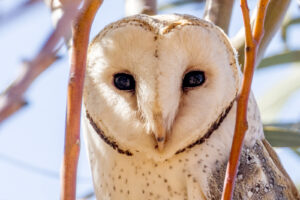
Is it rare to see a Barn Owl?
Whether or not it’s rare to see a barn owl depends on several factors, including:
Location:
- Globally: Barn owls are fairly common overall, being one of the most widespread land birds.
- Locally: Their abundance can vary significantly depending on specific habitats and prey availability. For example, they might be more common in areas with abundant rodent populations like farms or open grasslands.
- Urban areas: While they can adapt to urban environments, sightings might be less frequent compared to rural areas.
Time of day:
- Nocturnal: They are primarily active at night, making daytime sightings less common.
Behavior:
- Solitary: They are typically solitary birds, further decreasing the chances of seeing multiple individuals at once.
- Camouflaged: Their plumage effectively blends in with their surroundings, making them harder to spot during the day.
Considering these factors:
- If you live in a rural area with ample rodent populations, you have a higher chance of encountering a barn owl, especially at night.
- Seeing them during the day is less likely, as they are usually roosting in concealed locations.
- Even in suitable habitats, their solitary nature and camouflage can make them somewhat elusive.
Therefore, while barn owls are not considered exceptionally rare globally, seeing one might require some luck and being in the right place at the right time. Keep your eyes peeled at night, especially in areas with suitable habitat, and you might just be rewarded with a glimpse of this magnificent owl.
Are barn owls good or bad?
Barn owls are generally considered beneficial to humans and the environment, earning them a “good” reputation for several reasons:
Ecosystem Services:
- Rodent Control: Their primary prey consists of small mammals, particularly rodents like voles and mice. By consuming large quantities of these animals, barn owls play a crucial role in keeping rodent populations in check, benefiting agriculture and ecosystems.
- Seed Dispersal: They sometimes consume fruits and seeds, which can be inadvertently dispersed through their droppings, contributing to plant diversity in certain areas.
Cultural Significance:
- Symbolism: In many cultures, barn owls are seen as symbols of good luck, wisdom, and protection. Their silent flight and keen eyesight have fueled various mythologies and folklore throughout history.
- Aesthetics: Their distinctive appearance with heart-shaped faces and graceful flight patterns makes them aesthetically pleasing to many people.



